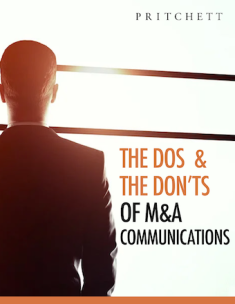M&A Communication Rules
Don’t ad lib. Plan your talk carefully and follow your plan. As the senior executive in the parent company, you have little opportunity to make insignificant remarks. Practically everything you say is taken seriously, studied for innuendo, or held up to the light for subtle implications. Even in routine conversation you need to be acutely aware of the impact of your comments. People will be trying to read things into almost everything you say. An offhand remark or slip of the tongue, and one of the best people in the acquisition could be gone or a new rumor started.
Don’t promise that things will remain the same in the acquisition. Most people won’t believe you anyhow, and most of those who do will later insist that you have lied or misrepresented things to them.
The traditional approach—the standard party line—goes something like this: “No changes in management are anticipated. The acquired company will basically continue to operate as it has in the past.”
People in the acquired firm don’t really believe it. A few of the more naive souls may accept it on faith (or hope), but most of the audience remain cynical and doubting. The irony, though, is that as the merger unfolds and the changes inevitably occur, virtually everyone in the acquisition will refer to top management’s earlier statements as hard proof that the parent company has reneged on its promises.
Early announcements about the merger are delicate messages. And giving people the impression that life will go on as usual is like walking into a management trap that has steel jaws.
There should be change, there will be change, and people know it. Just being acquired is change.
Point out to the audience that companies are constantly changing, whether they are being acquired or not. And just about any changes that happen to occur during the next few months will, in all likelihood, be blamed on the merger/acquisition whether that is appropriate or not.
An acquisition always represents some kind of a growth step for a company. So, prepare employees for the inevitable “growing pains” that are going to be felt. Help employees to understand that, to a large extent, the problems they will experience are a reflection of growth. After all, they do not want to be part of a stagnant organization. And the growing pains can be a positive sign.
So, explain that there will be changes, but that extreme effort will be made to (a) consider the interests of each employee and (b) keep them as well informed as possible of the coming changes.
Remember, if you acquire another organization and don’t make some changes, the odds are ten to one that you have failed to take advantage of outstanding opportunities that would be constructive and are needed.
It’s even risky to be emphatic in proclaiming, “We plan no management changes,” even when that is the truth. Likely as not, some employees will put you in the position of having to terminate them, and you will be accused of reneging on your promise.
So, promise change. That is a promise you can keep.
-
Sell the merger but be careful not to oversell. Hyping the merger is a seductive trap. Here again management can create unrealistic expectations, then violate those expectations and cause a new set of problems.
It must be remembered that the trust level is a fragile thing in merging companies. It is seriously threatened by the insecurities people are feeling. Sweeping statements designed to placate and reassure employees generally just add to the erosion of faith in what management says.
Skepticism makes people wary in the merger/acquisition environment. They search for evidence that contradicts what they are being told, and they frequently find it. Some will conclude that they have been deliberately misled. Others will view it as an honest mistake, yet they too will weigh more dubiously any subsequent announcement from on high.
Managers and executives protect their credibility when they prepare people for a certain amount of aggravation, frustration, and job stress—not like a prophet of doom, but like a realist.
It’s an issue of leveling with the people. It’s a management philosophy of “no surprises.”
Top management must remember it is dealing with adults—people who are trying to earn a living, build a career, raise a family. It does not pay to sugarcoat the facts.
Neither should management just throw people a sales pitch about the positive side of the merger and all the promise it holds. Employees should be given a balanced viewpoint. It’s a good news/bad news issue, where both sides of the story should be told.
The people can handle it. They deserve to know. And top management can’t fool them for long anyway.
You might succeed in creating some false hope by focusing strictly on the good news, and maybe that buys the company some time. But it carries a hefty price tag, because as people’s hope plays out, so does management’s credibility. And when employees’ hope and management’s credibility fade, they will be replaced with resistance, low morale, and cynicism.
It’s astute management to let people know what they can expect. Give it to them straight. They will respect you for it, and they will also be better prepared psychologically to cope with frustrating or undesirable events if (or rather, when) they do occur.
If the company gets lucky and things happen to go better than were predicted, top management may even be seen as heroes. At least employees won’t resent that turn of events, and the trust level will have been preserved. So instead of trying to make the merger transition period sound easy, take pains to paint both sides of the picture.
-
Protect your credibility and overall trust level. This is related somewhat to the prior guideline. The point here is that you should not try to be “popular.” Instead, try to be honest. Tell people what they need to hear, not what you think they want to hear. Realize that you can’t keep everybody happy, but you can be straightforward and believable. That’s about the best you can hope for. Just keep in mind that good marriages (corporate ones included) are based on honesty, not BS.
In the merger environment there are so many factors that chip away at management credibility and the trust level. You need to protect these with everything you’ve got.
-
Make few promises. Understand that promises of any type, as a general rule, will end up making life harder for you. In fact, even when you communicate something through innuendo, you can create expectations that will later prove to be a problem. Your hints will often be taken as hard data.
Employees will constantly push you to take a firm stand or give definite answers. But making promises is like playing with live ammunition. Again, at this stage of the game, about the only safe promise is that there will be changes.
-
Tell people at the outset that there will undoubtedly be some false starts and changes in the merger integration game plan. It is best to assure people upfront that management will almost certainly have to change its mind--on some things voluntarily, on others because circumstances will require it.
Employees in the acquisition should be told that some things that are done will end up being reworked or redone. It should be explained that the merger/acquisition will inevitably reflect a few management mistakes, and that management occasionally will have to back up and shift direction.
Why not lay it on the line and tell people that there are no “school solutions” to mergers, that instead there is much trial and error involved? It should be explained that a lot of merger management is impromptu and that the people in charge have to improvise and feel their way along some as the situation unfolds.
-
Emphasize the need for flexible management during the next year or so. Explain that the rewards will go to the people who are good change agents, who facilitate the changes rather than resisting them or feeling victimized by them.
Undoubtedly, during the next business decade it will be the flexible organizations that grow and flourish. And certainly, flexibility and adaptability are always required on the heels of a company being acquired or merged.
-
Tell people it’s okay for them to make some mistakes, too. Let them know that you will be tolerant of mistakes, but intolerant of inertia. The important thing to keep in mind is that, in both the parent company and the acquired firm, the greatest sins of post-merger management are sins of omission. And critical mistakes will be made by acquired company personnel if they opt to do nothing in an effort to avoid doing wrong.
For most people in an acquired firm the acquisition is a threatening experience. It creates feelings of uncertainty. The natural tendency is for people to become more inhibited in their work behavior. They grow more inactive, passive, and cautious. Insist they remain proactive, decisive, and willing to take appropriate business risks.
-
Put a large amount of responsibility for success of the merger/acquisition squarely on the acquired company’s employees. Make it clear that they cannot afford to sit and wait for the parent company to make things work. Particularly if they are to be left as a free-standing acquisition, they must grasp the fact that there is a new level of accountability.
Undoubtedly, during the next business decade it will be the flexible organizations that grow and flourish. And certainly, flexibility and adaptability are always required on the heels of a company being acquired or merged.
-
Ask for more (even while you may expect less) in terms of their overall corporate performance. Challenge the acquisition’s work- force by “raising the bar,” so to speak. Mergers and acquisitions destabilize and create dissonance in an organization. They serve as an unfreezing event, and this sort of organizational shakeup gets people’s attention. It rattles their cages, making them introspective. The time is right to push for new and better behavior/performance. Capitalize on the motivating potential a merger creates. It is a tremendous opportunity to re-energize people and organizations that have grown complacent and perhaps a bit stale. There is another point to be made here—if you don’t seize the opportunity and use the “dissonance” as a motivator, it inevitably will be a demotivator for many people.
-
Emphasize the need for leadership at all levels and explain how it typically is severely threatened during the merger/acquisition process. Note that the broad array of changes experienced by merging firms destabilizes corporate life. The resulting confusion and stress call for leadership. The changes also create a terrific opening for leadership. Managers need to realize that this can be their finest hour, because employees are looking for leadership.
-
Tell people to go looking for problems. And to report bad news. And to be big enough to ask for help. Share Charles Kettering’s comment, that “Problems are the price of progress. Don’t bring me anything but problems.” Explain that acquiring and merging companies can get to be a complicated management job. A certain number of foul-ups and breakdowns are to be expected. It’s just inconceivable that one can acquire or merge a company and not encounter some additional problems as a result of that.
One of the secrets to success: Instead of looking for proof that the merger is working, search for evidence that it is not.
-
Guard against a show of arrogance. Be humble. Go out of your way to avoid behaving in a manner that might be construed as arrogance, feelings of superiority, criticalness, abrasiveness, etc. People in the acquired firm will likely be defensive and easily threatened or intimidated. Make them feel valued. Build their corporate self-esteem.
The acquirer should reflect an appropriate level of corporate pride in its own organization, but it’s also good to (1) poke some fun at yourself and (2) show a reasonable level of candor regarding the parent company’s shortcomings or idiosyncrasies.
-
Give people a VISION. Give them hope, a sense of excitement, and a clear sense of direction. That can help diminish the ambiguity, clear up some of the confusion, and reduce the fear and anxiety. When companies are acquired, their future tends to get blurry, and they operate in a less purposeful fashion. Sometimes they become preoccupied with romanticizing the past. A corporate vision can help get people focused forward again.
-
Finally, remember that what you say actually counts for little, while what you do is everything. To put it differently, talk is cheap.
Sure, you can say the wrong things, and create all kinds of problems. But you can’t rely solely on talk to make everybody feel secure, happy, and accepting of the merger.
Your individual behavior, and the way the parent company manages the acquisition during the months ahead, will be what really counts. That’s hard data, solid evidence, and it speaks far more convincingly than words.





